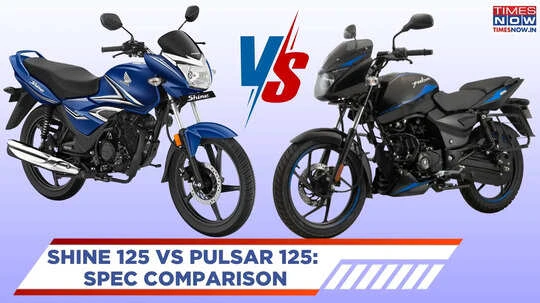With the new GST 2.0 reform, the tax rate for motorcycles up to 350cc has been reduced from 28% to 18%. This major revision has led to noticeable price cuts across the commuter bike segment, including popular models like the Honda Shine 125 and the Bajaj Pulsar 125. Here’s a detailed comparison between the two, including their latest prices, specifications, and features after the tax revision.
Honda Shine 125 Vs Bajaj Pulsar 125: Prices
Following the new GST structure, the Honda Shine 125 is now priced at Rs 78,539 for the Drum variant and Rs 82,898 for the Disc variant. The commuter motorcycle has seen a price drop of Rs 7,443. Meanwhile, the Bajaj Pulsar 125 now starts at Rs 85,633 for the single seat variant and Rs 87,527 for the split seat variant after a reduction of Rs 8,011. Despite the smaller price gap, both bikes now offer even better value, especially for daily commuters looking for reliable and efficient 125cc options.
Honda Shine 125 Vs Bajaj Pulsar 125: Engine Specifications
The Honda Shine 125 is powered by a 123.94cc single-cylinder, air-cooled BS6 engine producing 10.63 hp at 7,500 rpm and 11 Nm of torque at 6,000 rpm, paired with a 5-speed gearbox. It’s tuned for smooth performance and fuel efficiency, ideal for city use.
The Pulsar 125, on the other hand, gets a slightly more powerful 124.4cc twin-spark DTS-i engine. It develops 11.64 hp at 8,500 rpm and 10.8 Nm at 6,500 rpm, also mated to a 5-speed gearbox. The Pulsar’s higher power output makes it the sportier option of the two.
Honda Shine 125 Vs Bajaj Pulsar 125: Brakes and Tyres
Both motorcycles offer a front disc and rear drum setup. The Shine 125 uses an 80/100-18 front and 90/90-18 rear tyre combination, while the Pulsar 125 runs on slightly smaller 17-inch wheels with 80/100 front and 100/90 rear tubeless tyres. Both setups are well-balanced for city conditions, with good stability and grip.
Honda Shine 125 Vs Bajaj Pulsar 125: Frame, Suspension, & Dimensions
The Shine 125 features a Diamond frame with telescopic front forks and hydraulic rear suspension. It weighs 113 kg and offers 162 mm ground clearance. The Pulsar 125 uses telescopic front suspension with twin gas-charged shocks at the rear, a more performance-oriented setup. It’s heavier, at 140-142 kg, but offers slightly better stability with a 1320 mm wheelbase and 165 mm ground clearance.
